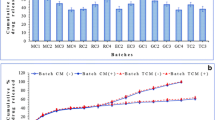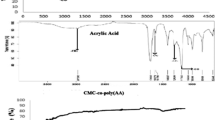Abstract
The purpose of this investigation was to prepare and evaluate the colon-specific microspheres of 5-fluorouracil for the treatment of colon cancer. Core microspheres of alginate were prepared by the modified emulsification method in liquid paraffin and by cross-linking with calcium chloride. The core microspheres were coated with Eudragit S-100 by the solvent evaporation technique to prevent drug release in the stomach and small intestine. The microspheres were characterized by shape, size, surface morphology, size distribution, incorporation efficiency, and in vitro drug release studies. The outer surfaces of the core and coated microspheres, which were spherical in shape, were rough and smooth, respectively. The size of the core microspheres ranged from 22 to 55 μm, and the size of the coated microspheres ranged from 103 to 185 μm. The core microspheres sustained the drug release for 10 hours. The release studies of coated microspheres were performed in a pH progression medium mimicking the conditions of the gastrointestinal tract. Release was sustained for up to 20 hours in formulations with core microspheres to a Eudragit S-100 coat ratio of 1∶7, and there were no changes in the size, shape, drug content, differential scanning calorimetry thermogram, and in vitro drug release after storage at 40°C/75% relative humidity for 6 months.
Similar content being viewed by others

References
Heidelberger C, Chaudhuri NK, Danneburg P, et al. Fluorinated pyrimidine. A new class of tumor inhibitory compounds. Nature. 1957; 179: 663–666.
Langenbach RJ, Dancenberg PV, Heidelberger C. Thymidylate synthetase: mechanism of inhibition of 5-fluorouracil-2-deoxyuridylate. Biochem Biophys Res Commun. 1972; 48: 1565–1571.
Parker WB, Cheng YC. Metabolism and mechanism of action of 5-fluorouracil. Pharmacol Ther. 1990; 48: 381–395.
Hahn RG, Moertel CG, Schutt AJ, Bruckner HW. A double-blind comparison of intensive course 5-fluorouracil by oral vs. intravenous route in the treatment of colorectal carcinoma. Cancer. 1975; 35: 1031–1035.
Liu G, Fraussen E, Fitch MI, Warner E. Patient preferences for oral vs intravenous palliative chemotherapy. J Clin Oncol. 1997; 15: 110–115.
Van Cutsem E, Peeters M, Verslype C, Filez L, Haustermans K, Janssens J. The medical treatment of colorectal cancer: actual status and new developments. Hepatogastroenterology. 1999; 46: 709–716.
Labianca RF, Beretta GD, Pessi MA. Disease management consideration. Drugs. 2001; 61: 1751–1764.
Diasio RB, Harris BE. Clinical pharmacology of 5-fluorouracil. Clin Pharmacokinet. 1989; 16: 215–237.
Yang L, Chu JS, Fix JA. Colon-specific drug delivery: new approaches and in vitro/in vivo evaluation. Int J Pharm. 2002; 235: 1–15.
Shun YL, Ayres JW. Calcium alginate beads as core carriers of 5-aminosalicylic acid. Pharm Res. 1992; 9: 714–790.
Krishnaiah YSR, Satyanarayana V, Kumar DB, Karthikeyan RS, Bhaskar P. In vivo pharmacokinetics in human volunteers: oral administered guar gum-based colon-targeted 5-fluorouracil tablets. Eur J Pharm Sci. 2003; 19: 355–362.
Madajewicz S, Petrelli N, Rustum YM, et al. Phase I–II trial of high dose calcium leucovorin and 5-fluorouracil in advanced colorectal cancer. Cancer Res. 1984; 44: 4667–4669.
Cortesi E, Aschelter AM, Gioacchini N, et al. Efficiency and toxicity of 5-fluorouracil and folates in advanced colon cancer. J Chemother. 1990; 2: 47–50.
O’Connell MJ, Mailliard JA, Kahn MJ, et al. Controlled trial of fluorouracil and low dose leucovorin given for 6 months as postoperative adjuvant therapy for colon cancer. J Clin Oncol. 1997; 15: 246–250.
Watts PJ, Barrow L, Steed KP, et al. The transit rate of different-sized model dosage forms through the human colon and effects of a lactulose induced catharsis. Int J Pharm. 1992; 87: 215–221.
Calis S, Arica B, Kas HS, Hincal AA. 5-Fluorouracil-loaded alginate microspheres in chitosan gel for local therapy of breast cancer. In: Muzzarelli RAA, Muzzarelli C, eds. Chitosan in Pharmacy and Chemistry. Grottammare, Italy: Atec; 2002: 65–69.
Lorenzo-Lamosa ML, Remunan-Lopez C, Vila-Jato JL, Alonso MJ. Design of microencapsulated chitosan microspheres for colonic drug delivery. J Control Release. 1998; 52: 109–118.
Martel P, Petit I, Pinguet S, Poujol S, Astre C, Fabbro M. Long term stability of 5-fluorouracil stored in PVC bags and in ambulatory pump reservoirs. J Pharm Biomed Anal. 1996; 14: 395–399.
Matthews BR. Regulatory aspects of stability testing in Europe. Drug Dev Ind Pharm. 1999; 25: 831–856.
Lin S, Kao Y. Solid particulates of drug-β-cyclodextrin inclusion complexes directly prepared by a spray-drying technique. Int J Pharm. 1989; 56: 249–259.
Lemoine D, Wauters F, Bouchend S, Preat V. Preparation and characterization of alginate microspheres containing model antigen. Int J Pharm. 1998; 176: 9–19.
Wagner JG. Interpretation of percent dissolved-time plots derived from in-vitro testing of conventional tablets and capsules. J Pharm Sci. 1969; 58: 1253–1257.
Higuchi T. Mechanism of sustained action medication. J Pharm Sci. 1963; 52: 1145–1149.
Korsmeyer RW, Gurny R, Doelker E, Buri P, Peppas NA. Mechanisms of solute release from porous hydrophilic polymers. Int J Pharm. 1983; 15: 25–35.
Dubernet C. Thermo analysis of microspheres. Thermochim Acta. 1995; 248: 259–269.
Mu L, Feng SS. Fabrication characterization and in vitro release of paclitaxel (Taxol) loaded poly (lactic-co-glycolic acid) microspheres prepared by spray drying technique with lipid/cholesterol emulsifiers. J Control Release. 2001; 76: 239–254.
Costa P, Labo JSMS. Modelling and comparison of dissolution profiles. Eur J Pharm Sci. 2001; 13: 123–133.
Food and Drug Administration. Guidance for Industry: Dissolution Testing of Immediate Release Solid Oral Dosage Forms; 1997. Rockville, MD.
Author information
Authors and Affiliations
Corresponding author
Additional information
Published: May 26, 2006
Rights and permissions
About this article
Cite this article
Rahman, Z., Kohli, K., Khar, R.K. et al. Characterization of 5-fluorouracil microspheres for colonic delivery. AAPS PharmSciTech 7, 47 (2006). https://doi.org/10.1208/pt070247
Received:
Accepted:
DOI: https://doi.org/10.1208/pt070247



